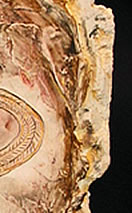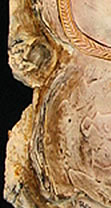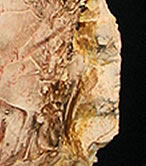 |
|
||||
| Previous | Gallery | Next |
 |
|||||
 |
 |
||||
 |
 |
||||
 |
|||||
 |
|||||
 |
 |
||||
 |
 |
||||
YAM PLANT COLORS included in this piece are kohl, ground clay, amarillo medio, yellow ochre, dirt from Chimayo , New Mexico and Sedona , Arizona and saffron. Saffron is a bright orange-yellow color. It is one of the world’s most expensive and oldest spices. The earliest reference to saffron is believed to be from a seventh-century B.C. Assyrian botanical text. Ancient Sumerians and Phoenicians extracted its oil, a key ingredient in their perfumes. Ancient people were also aware of saffron’s medicinal properties. The Ebers Papyrus, a 1500 B.C. Egyptian medical text, currently in the library at the University of Leipzig , recommends saffron for kidney ailments. BACKGROUND is eggshell. TEXTURING is medium density with borders that are irregular and rocky in appearance. SIZE is 17”H x 12”W CULTURAL INSPIRATION: From Goulburn Island, within the western Arnhem Land art tradition comes this bark painting of a yam plant. It is from the Maung tribe. The yam plants of this type are a staple diet of the Mimi spirits. Clearly seen at the top is the flower or pod with leaves. The edible part of the plant, the bulb is at the bottom. The tendrils are the yam fibers. Not only are yams a bush food, they also play an intricate part in ceremonies, including initiation ceremonies. The yams are cooked in red-hot embers on the ground for about two hours. In one ceremony, yam slices are crunched and rubbed in each other’s heads and faces. In a ceremony for abundance of food, yams are skinned and cut up in slices on ceremonial ground while the men chant “yams, you are our fathers”. There are numerous varieties of yams including “kolamma” a variety purported to possess special properties not associated with other yams. It is a prevalent notion among medicine men that they are not to eat hot things. Kolamma is a very hot yam that requires special preparation to make it safe to eat. They need to be treated and if not prepared correctly before being eaten, they will cause irritation in the mouth. Searching for food was dictated by the seasons and sex roles of the food collectors are very specific. Men were in charge of hunting large land and sea animals; women would gather vegetables and tubers, small mammals, shellfish and eggs. The woman may provide up to 80 percent of the group’s food supply. Traditionally when women collected the tubers they would leave a little of it in the ground. Yam is always put back to appease the yam spirit. One aboriginal woman tells her children: “When you dig up yam, you must all the time leave a little bit end of that yam in ground…if dig it all out, then that food spirit will get real angry and won’t let any more yam grow in that place”. |